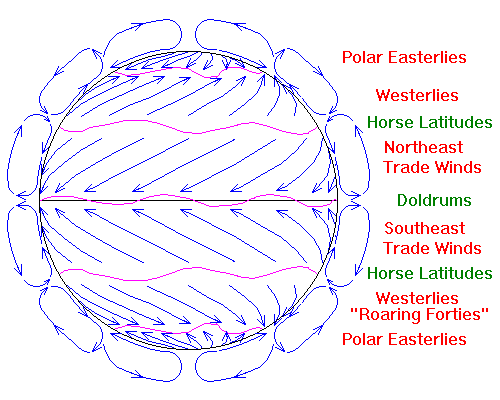Difference Between Doldrums and Horse Latitudes

Doldrums vs. Horse Latitudes
Doldrums and horse latitudes are ocean regions on the Earth. Specifically, doldrums are ocean belts near the equator. The region is characterized as having little to no wind. This lack of wind has been a problem in sea exploration in the last centuries since ships cannot move if there is no wind.
Doldrums can be found in both the Atlantic and Pacific Oceans. Doldrums are located five degrees to the north and five degrees to the south near the equator. The lack of wind in the doldrums can last for a long period of time. This happens because the sun’s intense heat contributes to the warming of the air, and it climbs into the atmosphere.
Due to the rising moist air, doldrums can also develop into extreme weather like massive storms, squalls, thunderstorms, or hurricanes. This resulting weather also disrupts a ship’s movement and journey. Both the lack of wind and extreme weather cause casualties at sea by prompting low supplies, starvation, sickness, and eventually death.
The term “doldrums” originated from the dull or slow-moving experiences of sailors in this area during the 18th century. These adjectives were later adapted and used to describe the place.
On the other hand, horse latitudes are also two ocean belts located near the equator. They are placed at exactly 30 degrees north and south latitude. Like doldrums, the areas of horse latitudes have clear skies with little or low airflow.
Horse latitudes are also called subtropical latitudes. They are under a high-pressure ridge area called a subtropical ridge. Unlike doldrums, horse latitudes create dry environments and mostly deserts like the Sahara Desert, Atacama Desert, Kalahari Desert, and the Australian Desert. Other areas that horse latitudes created are the southern areas of the United States, northern Mexico, and the Middle East.
Like doldrums, horse latitudes have an unusual origin. The name can refer either to the horse effigy or live horse thrown overboard by sailors crossing the Atlantic Ocean. The horses were thrown overboard to conserve food and water. In addition, the ship’s load is lightened, enabling it to sail at more desirable speeds. The Spanish were credited for throwing the live horses overboard.
Summary:
1.Both doldrums and horse latitudes are ocean areas characterized by weak or nonexistent airflow for a prolonged period of time. Both areas are also located in the Atlantic and Pacific Oceans. In addition, both places are near the equator.
2.Doldrums and horse latitudes are situated in different locations near the equator. Doldrums are placed at five degrees north and south of the equator. Meanwhile, horse latitudes are located at 30 degrees north and south latitude.
3.The air existing in doldrums is moist, while horse latitudes’ air is dry.
4.Doldrums can cause extreme weather like squalls, thunderstorms, and hurricanes. On the other hand, horse latitudes cause the formation of deserts and other hot and dry areas.
5.Human casualties were also an effect of doldrums and horse latitudes in ship exploration. Lack of wind for a long period of time can cause starvation, meager supplies, sickness, and death of the ship’s crew. In the case of doldrums, human casualties can double if an extreme storm or hurricane appears. In addition to casualties, the resulting weather disturbance can cause shipwrecks and castaways.
6.Both doldrums and horse latitudes have been attributed as places or causes of delayed ships. Doldrums originated as a description of sea life in the area, while the term “horse latitudes” was coined due to the practice of throwing live horses or horse effigies overboard by early sailors to promote ship movement and speed.
- Differences Between Fraternity And Sorority - January 8, 2014
- Differences Between Lucite and Plastic - January 7, 2014
- Differences Between Oil and Butter - January 6, 2014
Search DifferenceBetween.net :
8 Comments
Leave a Response
References :
[0]http://isearchnotes.com/single.php?id=273

quite good, remarkably explanation.
Beautifully explained…thank you so much
Very good explanation
Item 4 in the summary says that the Doldrums “can cause extreme weather like . . . . and hurricanes”. This seems to be quite incorrect as there is very little in the way of net Coriolis effect so close to the equator. Any low pressure center there would draw air parcels from both north and south sides of the equator and their Coriolis effects would therefore cancel out . . . preventing the spin-up of a hurricane. No doubt there can be extreme weather in the Doldrums, but a hurricane seems impossible.
In the doldrums, due to intense heating of the sun moist air rises up creating a low pressure below. But as and when a low pressure is created at doldrums, wind from adjacent areas ( trade winds) should automatically fill this low pressure. Why this is not happening???
Perfectly Explained !!
Thank you …the content is worth reading..
Superb!Sailing high with this kind of treasury bank knowledge An Excellent explanation offered info to navigate the tempo of knowledge hungry to non saulty sweet watertank thank You Honourable Sir!